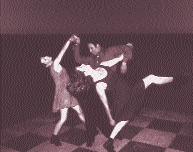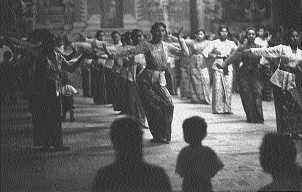June 1997
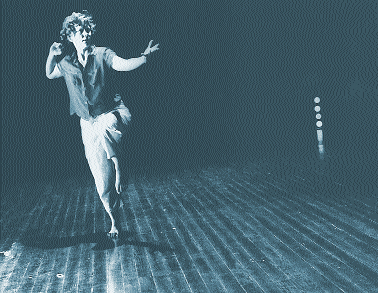
Jennifer Monson
photo Heidrun Löhr
Jennifer Monson
The Sydney Morning Herald’s dance writer, Jill Sykes, in her not-so-kind comments about the performance programs in The Performance Space’s antistatic festival must have known she was poking a stick in a hornet’s nest. Perhaps she was emphasising her desire (Performance Space Quarterly, Autumn 1997) to express ‘one person’s view’ in what should be— ideally, but is not—in our economic rationalist climate, a widely diverse debate about innovative dance practice. The sort of attitude expressed in Jill Sykes’ review reveals the ease with which alternative discourse is effectively silenced. Different notions of the body have engendered much innovative dance practice, but in Australia, these differences seem doomed to invisibility within the larger public domain.
To wit, the National Library of Australia is currently host to a travelling exhibition, Dance People Dance, curated by Dr Michelle Potter. Despite the Director-General’s comment that the exhibition “examines how theatrical dance in Australia has moved from its strongly Western European beginnings to now also reflect an ethnically diverse society”, this exhibition tells a story of Australian dance shaped entirely by its relationship to European tradition. Max Dupain’s photographs bring to life the early tours of Pavlova and the Ballet Russe which were so influential in developing our national ballet. Thrown into prominence are a group of contemporary Australian artists defined by this same theatricality: Meryl Tankard, Graeme Murphy, Stanton Welsh, Gideon Obarzanek, Paul Mercurio—all with European balletic pedigrees falling clearly on the right side of well-worn tradition.
For reasons unspecified, there are few developed references in the exhibition to other non-balletic dance traditions practiced in Australia for generations. Early Modernists are given little more than glancing recognition: the odd TasDance and One Extra poster. Neither is there material from more recent visits of, say, Steve Paxton, whose work has inspired generations of dancers in Australia. There’s an awkwardness in the way that Indigenous Australian dance is barely accommodated within the body of the exhibition.
Can interesting, successful dance be conceived of as more than commercially viable entertainment? Might different understandings of the body and dance centre on a person as an inherently mobile and expressive being? Can the body be seen as a site of inquiry, investigation and negotiation, rather than some unruly and inchoate pit of desire and impulse requiring severe discipline in order to achieve a pre-established social demeanour? Certainly these used to be fashionable ideas. The early practices of Murphy or Tankard were well-funded, ostensibly on the basis of their ‘modern’ desires. To see clearly where an artist’s aesthetic aspirations lie, you simply look to daily technical training regimes. These individuals have always sat comfortably within balletic practice. Whether they have “dented the canon” or not, to use Russell Dumas’ description of innovation in ballet, is questionable. The point is that if the idea of innovation is fashionable, its actuality is usually too problematic for public presentation.
The suggestion that our Western European theatrical heritage still provides the most influential model, would probably raise little dispute among the six member panel at the surprisingly named National Dance Critics Forum: Dance: What Next? Who Says So? Few of the panellists would have experienced dance which was about physical negotiation and investigation rather than proclamation and spectacle.
If Valerie Lawson sees the cult of the creative personality as ‘unhealthy’, to be discouraged in favour of ‘creative collaboration’, I wondered, without denigrating such enterprises, where Sydney Dance Company would be without the public charisma of Graeme Murphy. Simultaneously, even from within this ‘cultist’ mentality, contemporary economic argument requires that singular innovative artistic vision be smoothed out by less problematic, consumable, easily-toured, blander ‘international’ fare. In the case of Western European dance, you’re always in reassuringly familiar terrain, knowing how to talk, what values to acclaim. One talks about a certain style, extreme physicality and virtuosity. Dancers can travel all over the world and all partake of this same discourse. Perhaps this is what Robin Grove referred to, when discussing classical tradition in the 21st century, as “the high democracy of this art, where everyone is king”. And he wasn’t just talking about ballet, but about a classicism in which one apportions “harmonious lines in an internal coherence”, a notoriously and meticulously de- and re-constructed idea, within the post-modernist frame.
Lee Christofis, commenting on funding problems for independent artists, equated the term ‘independent’ with ‘emerging’, conveying the idea that once artists have ‘emerged’ they will no longer be ‘independent’. Further, he implied these artists might just be unwillingly ‘independent’ of funding bodies’ financial assistance. Either alternative misunderstands a more pertinent notion of independence, ie mature, wilfully artistically independent choreographic artists deliberately seeking to develop practices which speak diversely of the body—not as a well-oiled culturally ‘international’ machine, or couched in pre-defined terms which devalue difference. Such artists engage in a dialogue about practice that acknowledges Australia’s monogamous relationship with its Western European cultural referents, at the same time setting about widening cultural precepts and creating a truly independent identity.
To this end, perhaps, the antistatic festival’s centrepiece was the three ten-day workshops conducted by guests Jennifer Monson (NY), Julyen Hamilton (Spain via UK) and Gary Rowe (UK), designed to develop choreographic and improvisational practice and performance—the very practices evident in the performances which failed to impress Jill Sykes.
If a choreographer makes work to which only a specific audience can relate, is that grounds for dismissal? Such was Gary Rowe’s A Distance Between Them, in which the iconography may well have related to an audience (HIV positive men?) which did not attend. Indeed, the images remained static, distant and difficult: tight in a circular frame a woman singing Doris Day love songs, a sparse film showing a mother’s pregnant belly, a man’s throat. A tortured dancer, pinned in a hard-edged spot, dances as if forever on a steadily speeding treadmill. Tiring, repetitive phrases accumulate. Unexpectedly, sympathy finally arises for someone caught in the grip of a difficult life.
Julyen Hamilton’s 40 Monologues was like being taken for a ride. No need to specially watch for anything in this pre-edited stream-of-consciousness movement and dialogue. His art of movement non-sequitur used physical latitude that would amuse fans of old John Cleese-type word association football games. It was probably in that same wave of innovation 30 years ago that his technique developed, on the contact improvisation platform, fused in his case with more established modern techniques. These days he moves and talks with the facility and impeccable timing of a well-practiced comic.
On a similar ‘contacterly’ platform, Jennifer Monson’s work, Lure was far less straitened by early modernist vocabularies. Her strength and fluidity revealed glimpses and passages of tricky sensibility, of magical ticklishness. Sometimes the sea, its myths and enticements manifested. She stepped through waves of piquant suggestion, continuous currents of shifting sensibility. Dynamics grew and abated. She gathered her energy and hurled herself in belly flops to the floor, or else engaged with feathery and evasive wisps of tiny paper sails which rode on her breath.
New work rarely springs from nothing. Russell Dumas’ and Lucy Guerin’s works The Oaks Cafe —Traces 1 and Robbery Waitress on Bail shared a stylistic linearity given vigour and depth by webs of allusion. If, as Dumas says, ballet, like most hybrid arts, is sterile, The Oaks Cafe Project seemed to assert that the accumulated contributions of individuals (Sally Gardiner, Trevor Patrick, Pauline de Groot, Catherine Stewart), because of their particular relationships with Dumas’ artistry within their own layered experience, can suggest ways of escaping such perceived aesthetic inertia.
Lucy Guerin’s allusions perhaps highlighted an uneasy relationship between Australian/American and European escapist imagery, throwing together bland journalistic accounts of a Pulp Fiction-like restaurant theft story with the angst-ridden world-weariness of say Anne Teresa De Keersmaker’s women, who show their legs and nickers with a familiar double-edged indifference.
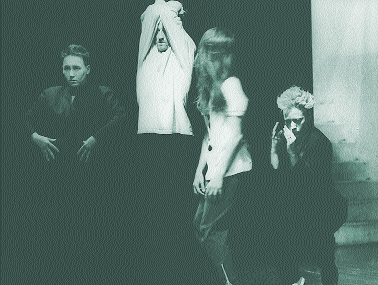
The Performance Union
photo Heidrun Löhr
The Performance Union
Lines of movement inquiry can become inert behind stylistic facades. Butoh Product (de Quincey/Lynch Performance Union) refers to ‘traditional’ Butoh, which, having been engendered in revolt, can only continue to exist by undercutting and shattering its own halo-effect, so that innovation cannot become canonised. The artists set up scenes of serious intent—’performer’, ‘singer’, ‘dancer’, ‘guest’, ‘audience’ and then proceeded to expose their flimsiness. An on-stage filming later revealed a rearrangement of the same performance elements, delivering quite a different version of events.
Martin Hughes did not deal well with the familiar technical skills of straight contact improvisation. Helen Clarke-Lapin, his highly-skilled partner, might have taken this dance much further on her own, or with musician Ion Pierce, without losing that vital sense of physical negotiation, the raison d’être of contact, and without becoming lost in the look.
It’s a big ask of any one artist to delve into totally unknown material, as Tony Osborne may have tried to do in the velvet ca. The results, for an audience expecting refinement at least, could be construed as adventurous, if undeveloped and fairly yukky as the dancer dredged up his psychic child to play with.
A duet which did not lack refinement was Duet from Trio choreographed by Ros Warby with Helen Mountfort (cellist). Warby’s as sensitive as a delicately boned, two-footed creature can be, her movement almost disappearing in an ecstasy of sentience. In this vein too was Alice Cummins’ Lullaby, where simple, sometimes foetal movements seemed cradled in an adult text. The sound of her words soothed a difficult transition from the familiar to the unknown, like rocking soothes a baby. Six Variations on a Lie didn’t work as well in this cavernous space as it did in its more intimate home venue. There, performers formed a sparse and elegant quartet, an ensemble of soloists (dancer Rosalind Crisp, singer Nikki Heywood, sound artist Ion Pierce, and visual artist James McAllister). In The Performance Space, without the focus and cohesive physical relationships that confinement produced, the four seemed to wander alone.
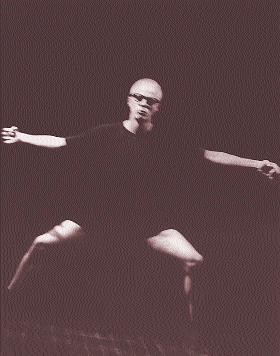
Jon Burtt
photo Heidrun Löhr
Jon Burtt
Jon Burtt and Alan Schacher are both comedians, perhaps of different sorts. In Cars, TVs and Telephones, Burtt was a gangly, fashionably nerdish but charming kind of guy, whose understated-yet-sexy chat about household appliances to the accompaniment of funky music and articulate movement, made this work totally watchable. In trace elements/residual effects Alan Schacher, working in caricature, tried to make visible his gnarled and inexplicable life in a dusty Central Australian landscape. His movement captured parched, twisted branch, dry reptilian skin, and a lost, alien and absurd human, in what started and finished as funny and moving, but fell into a hole in the middle.
Helen Herbertson, in a strange excerpt from her full-length Descansos, was revealed in less sympathetic light (and shadow) as a lone, almost comic figure, without the dignity and stature which characterised the original work. Shelley Lasica (Square Dance Behaviour—Part 6/version 4) spent a lot of time taping padding under her costume. If her comments referred to ‘embodiment’, or shape and line and their interpretation by an audience, the ‘deformities’ seemed to make absolutely no difference at all. A stronger statement might have been to simply leave the stage after the padding had been strapped on. No dancing at all. Leyline Co’s comment on the facade of clothing and appearance was no more compelling, despite (or because of) the high-heeled déshabille of the two dancers as they pretended to clamber unbecomingly along parallel catwalks.
During the second weekend (March 28–29), the antistatic forums opened appropriately with Libby Dempster (“Ballet and its Other”) discussing the negative ‘otherness’ attached to non-balletic forms which, by default, are defined within the binary opposition which ballet sets up. Dance is either ballet or not ballet. Her paper was complemented by Russell Dumas’ explication of the way in which traditional European practice has defined all Australian practices in one way or another within this inescapable binary construct. With its persuasive employment of all the theatrical forms—stage design, lighting, music, set, costumes etc—it provides a kind of inscription to the mind and muscles. Unbeknownst to many practitioners, choreographic practice in Australia is situated as an art by way of its association with this inscription, the ballet trained body. So for Dumas it becomes irrelevant whether it’s deployed by MTV, musical comedy, Gideon Obarzanek, Meryl Tankard or Graeme Murphy, because what you’re seeing is a dancer trained in a regime, and the authority of this dancer’s presence is the outwardness of the display. Other traditions too, various manifestations of Expressionist angst, Butoh, ‘new’ dance practices, are paraded as innovative, but then put within this theatrical context, which simultaneously invigorates the relationship with classical tradition, while suppressing any consciousness of that relationship.
Russell Dumas outlined a different choreographic lineage: the early German Expressionist school of Laban, Wigman and Hanya Holm, having developed as an oppositional practice to European balletic tradition, escaped to 1930s America, and being full of the angst of that position, invigorated a different kind of cultural stance—one which is traceable to that country’s foundation, a rejection of these European values, and one which did not develop in opposition to the European balletic tradition. It defined itself in terms of independence, national pride, the rhetoric of which, noted Libby Dempster, Americans have felt able to work to their own ends in a variety of ways.
Dumas’ intention was not to deride Australian choreographers—despite his comment that “this is indeed the land of the dance Demidenkos”—or to persuade us to emulate the American model. Rather, he suggested that by being able to cite our cultural references, understand our historical precepts, and recognise our relationship within that tradition, we might infuse life and real innovation into an otherwise derivative national choreographic enterprise.
–
Dance People Dance, National Library of Australia, curator Dr. Michelle Potter; National Dance Critics Forum: Dance: What Next? Who Says So? April 26; antistatic, The Performance Space, Sydney March 21–April 4
RealTime issue #19 June-July 1997 pg. 26-27
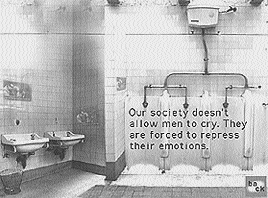
Video Positive 97: Escaping Gravity
Video Positive 97: Escaping Gravity (VP97), billed as the UK’s biggest ever festival of video and electronic art, spanned two cities (Liverpool and Manchester) and 12 venues. With approximately two hundred artists included in the various exhibitions, installations, film and video programs, festival audiences needed serious doses of caffeine as well as dedication to experience all that was on offer. The festival also included three conferences: LEAF 97 (exploring art, society and technology from an east-European perspective) Cosmopolis: Excavating Invisible Cities (investigating the transition from the post-industrial to the digital city) and Escaping Gravity: The Student Conference.
As well as presenting work at standard festival venues such as galleries and theatrettes, VP97 also placed work in less traditional venues including Cream at Nation, a popular nightclub venue in Liverpool, cafes, and the Museum of Science and Technology in Manchester. The Liverpool cathedral’s oratory was the site for Bill Viola’s video installation The Messenger, a mesmerising work showing a submerged, almost lifeless, human figure slowing rising to the surface and gasping air before again descending to repeat the sequence over and over again. Viola’s work was an eerie experience for viewers who became aware, as their eyes got used to the dark interior, that they were standing amongst lifeless stone statues. The VideoWall at Wade Smith, a sports store in Liverpool, was another imaginative but somewhat problematic foray out of the art institutions into the ‘real’ world. Audiences trying to view George Barber’s Video High Volume 2 were just as likely to be greeted with a half hour Nike ad which was alternated with Barber’s work.
There was a strong Australian presence at VP97 in the form of the aliens.au program curated by Linda Wallace and financially supported by the Australian Film Commission. Jon McCormack’s startling and poetic ‘artificial life’ progeny were exhibited in his Turbulence installation in the Museum of Science and Industry in Manchester.
In Lyndal Jones’ From the Darwin Translations: Spitfire 1.2.3. audience members moved through a room full of monitors displaying images of poppy fields with an accompanying soundtrack of birdsong into a darkened room dominated by a large screen showing footage of a pilot’s eye view from the cockpit of a Spitfire fighter plane. An intimate atmosphere was created by headphones which positioned the individual audience members in the cockpit’s aural interior (engine and propeller noises), as disembodied women’s voices told stories of their sexual fantasies about the archetypal warrior pilot.
Gordon Bennett’s Performance with Object for the Expiation of Guilt (Violence and Grief remix) was presented via video with artefacts from the performance (black whipping box and stock whip) adding a disturbing physical presence. Exploring the complexities of black/white racism and the construction of the Other, his was one of the most overtly political works in the festival.
Also included in the aliens.au program were two video programs and five CD-ROMs: Martine Corompt’s The Cute Machine, Josephine Starrs’ and Leon Cmielewski’s User Unfriendly Interface, Brad Miller’s Planet Of Noise, Lloyd Sharp’s Invert and Patricia Piccinini’s Genetic Manipulation Simulator. These works were presented as part of a ‘CD-ROM Forest’ in the Museum for Science and Technology; inexplicably, the sound was turned down very low on these works creating a somewhat barren experience as audiences wandered between the discrete computer terminals.
Other highlights of the festival were Jaap de Jonge’s (Netherlands) Crystal Ball, a magical kaleidoscope eye mounted into the wall of the Cornerhouse Gallery in Manchester. Viewers responding to the message touch me were rewarded with fragmentary images of TV and cable broadcasts scanned from the mediascape. In Liverpool at the Open Eye gallery, Thecla Schiphorst’s (Canada) Bodymaps: Artefacts of Touch incorporated sensors under a white velvet surface. A near life-sized figure projected onto the surface twisted, turned and moved in response to audience members touching and stroking the velvet. Jane Prophet’s (England) high-tech fibreglass cyborg Sarcophagus was animated by the audience passing their hands over different ‘body’ zones—head, heart and stomach—which displayed images representing biological and informational systems.
The success of the exhibition installations was due in no small part to the impressive array of equipment the organisers of the festival, FACT (Foundation for Art & Creative Technology), based in Liverpool, were able to secure for the artists. A pool of equipment from MITES (Moving Image Touring & Exhibition Service)—including 25 video projectors as well as computers and laser disc players—made up approximately half of the equipment used, with the remainder secured through various sponsorship deals.
ISEA98 (themed ‘revolution’) is set to build on the VP97 collaboration between Liverpool and Manchester and is being organised by FACT in conjunction with Liverpool University and Manchester Metropolitan University, and with the support of local councils which are demonstrating a high level of commitment to the cultural and economic opportunities presented by new digital technologies.
Video Positive 97, Liverpool and Manchester, April 11–May 18
More information on the festival and the artists can be found online at: http://www.fact.co.uk/VP97.html [expired]
The homepage for the aliens.au program can be found online at:
http://www.anat.org.au/aliens
RealTime issue #19 June-July 1997 pg. 25
There are times when what we see in performance or visual art speaks more about us as witnesses than it does about the artist. So it seemed for me with Ricochet, the latest work presented by Perth-based independent contemporary dance company Physical Architecture is Dancing at Canberra’s Choreographic Centre. The bureaucratic game is the subject here, explored and teased out in all its nightmarish incarnations.
There is a worshipping of false gods to open the work, as six power-suited women move through the space, each carrying a different plastic icon on a platter—toy car, Barbie’s couch and taut Ken doll. A confession-of-sorts to the plastic demi-gods gets the piece going, and the momentum is maintained.
Running towards us, stomping, marching, sometimes bouncing, slapping the floor, vertical lines in the space, backwards and forwards. Voices hang in the air, almost tangible, but more often creating a layering of sound with Lee Bradshaw’s original sound composition. There’s mention of ‘quality assurance’ and a meeting about ‘how to cope with change’. The text sits remarkably well in all this, set against the pace of the movement in one section and mirroring it in the next.
Choreographer/Artistic Director Tamara Kerr has also drawn on mask work—a result of the developmental creative process that a residency at the Choreographic Centre affords—and it is effective. Twisted, exaggerated expressions with lips absurdly distorted. Lunging towards us, declaring, “make my day” and “kiss my arse”, the women play up their roles oh so deliciously.
Ricochet is noisy, manic and energetic. It is also a tongue-in-cheek examination of the juggling game of women’s goals and desires in the corporate world.
Ricochet, Physical Architecture is Dancing, The Choreographic Centre, Canberra, April 19
RealTime issue #19 June-July 1997 pg. 28
What I wanted, more than anything, for this piece of work was a clearer commitment to abstraction in its own terms. All of the elements of the work—the dancers, the choreography, the engagement of music to movement, us sitting there in an implausible performance space, were diminished for me through the application of narrative. I wanted to honour these parts of the sum, to follow the lines offered up through the dancing bodies, through the very idea of that hotel dining room being the space to have generated the work. I have been in enough old buildings made into museum sites to know about the layers of story, traces left behind. I wanted to be allowed to do some of that work of interpretation myself without the imprint of storytelling.
Aside from that interpretive space I yearned for, the work with all of its leaning, its support and withholding, of passion and its repercussions, was pretty satisfying. To start with, the dancers were fine and spirited, making dramatic the otherwise prosaic space. Paul O’Sullivan, Setefano Tele, Jane Diamond, Shelley Mardon. In solo and in often fiery relationships, the register of passionate gestures and movement was always engaging, as long as it wasn’t trying to illustrate words (ban the words!). There was some deeply sexy choreography here, bodies slamming around in quite a charge. An encounter between the two men was a particularly thrilling, physical delight.
I don’t want to deny dancers their voices, but the eloquence of their movement surpassed all story lines offered here. Fieldworks continues to attract fine performers, and the collaborative approach of making work is also to be admired. The inclusion of blues musician Ivan Zar to provide what sounded like an improvised guitar and harmonica track was another delight.
I Lean on You, You Lean on Me, directed by Jim Hughes, Fieldworks Performance Group, Old Peninsula Hotel, Maylands, Perth. April 1997
RealTime issue #19 June-July 1997 pg. 28


